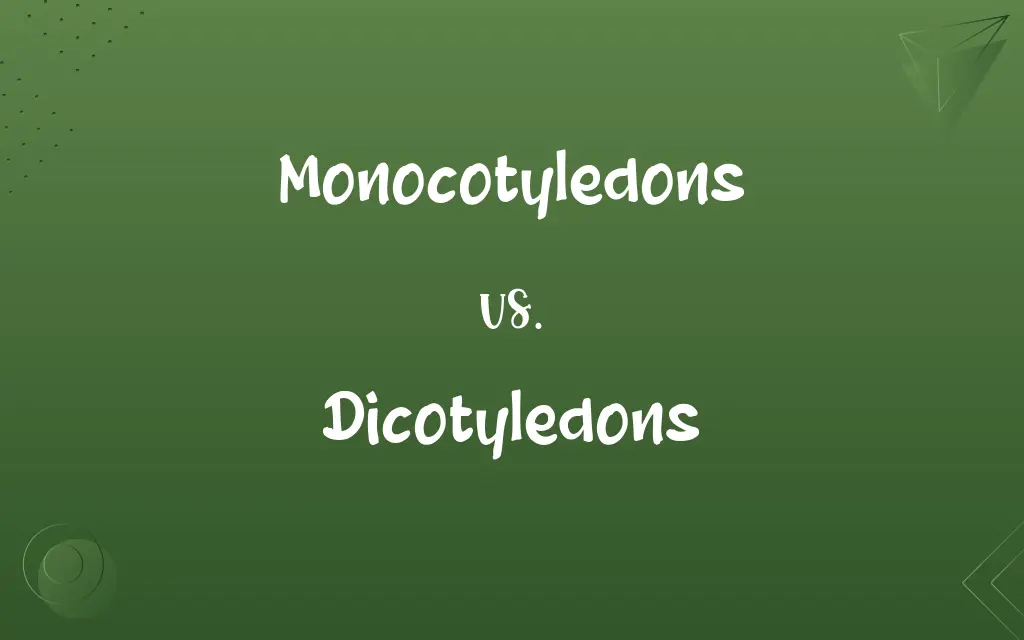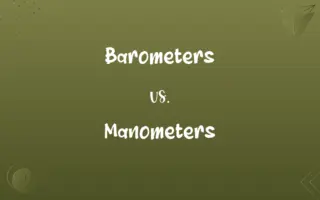Monocotyledons vs. Dicotyledons: Know the Difference

By Shumaila Saeed || Published on February 12, 2024
Monocotyledons (monocots) have one seed leaf and parallel leaf veins, while dicotyledons (dicots) have two seed leaves and branched leaf veins.

Key Differences
Monocotyledons have a single seed leaf (cotyledon), which is crucial during the germination process. This single cotyledon is a defining feature of monocots. Dicotyledons possess two seed leaves, which often emerge above the soil during germination. These two cotyledons are the primary difference from monocots.
Shumaila Saeed
Feb 12, 2024
In monocotyledons, flower parts usually come in multiples of three. This pattern is consistent across various monocot plants. Dicotyledons often have flower parts in multiples of four or five, distinguishing them from monocots in their floral arrangement.
Shumaila Saeed
Feb 12, 2024
Monocotyledons have vascular bundles (xylem and phloem) scattered throughout the stem, which affects how the plant grows and supports itself. Dicotyledons possess vascular bundles arranged in a ring within the stem, a feature that contributes to the potential for increased growth in thickness (secondary growth).
Shumaila Saeed
Feb 12, 2024
Monocotyledons typically have a fibrous root system, where roots spread out in the soil like a mat, providing a wide area of absorption. Dicotyledons usually develop a taproot system, with a main central root that grows deep into the soil, accompanied by smaller lateral roots.
Shumaila Saeed
Feb 12, 2024
Comparison Chart
ADVERTISEMENT
Stem Vascular Bundles
Scattered throughout stem
Arranged in a ring within the stem
Shumaila Saeed
Feb 12, 2024
Monocotyledons and Dicotyledons Definitions
Monocotyledons
Monocots typically have a widespread, shallow root system.
Wheat, a monocotyledon, develops a fibrous root system.
Shumaila Saeed
Jan 13, 2024
ADVERTISEMENT
Dicotyledons
Dicots typically have a deep, central root system.
Carrots, as dicotyledons, develop a prominent taproot.
Shumaila Saeed
Jan 13, 2024
Monocotyledons
Plants whose leaves show parallel venation.
Grasses, typical monocotyledons, have parallel veins in their leaves.
Shumaila Saeed
Jan 13, 2024
Dicotyledons
Plants with two embryonic leaves or cotyledons.
Beans are dicotyledons.
Shumaila Saeed
Jan 13, 2024
Monocotyledons
Plants with one embryonic leaf or cotyledon.
Corn is a monocotyledon.
Shumaila Saeed
Jan 13, 2024
Dicotyledons
Plants whose leaves have a network of veins.
The leaves of roses, which are dicotyledons, show a branched vein pattern.
Shumaila Saeed
Jan 13, 2024
ADVERTISEMENT
Monocotyledons
Their stems have vascular bundles spread out.
In bamboo, a monocotyledon, the vascular bundles are scattered throughout the stem.
Shumaila Saeed
Jan 13, 2024
Dicotyledons
Flowers of dicots often have parts in multiples of four or five.
Peonies, being dicotyledons, often have five petals per flower.
Shumaila Saeed
Jan 13, 2024
Monocotyledons
Flowers of monocots often have parts in multiples of three.
Lilies, as monocotyledons, usually have six petals.
Shumaila Saeed
Jan 13, 2024
Dicotyledons
Their stems have vascular bundles in a ring pattern.
In oak trees, which are dicotyledons, the vascular bundles are arranged in a ring.
Shumaila Saeed
Jan 13, 2024
Monocotyledons
Any of various flowering plants, such as grasses, lilies, and palms, having a single cotyledon in the seed, and usually a combination of other characteristics, typically leaves with parallel veins, a lack of secondary growth, and flower parts in multiples of three.
Shumaila Saeed
Jan 11, 2024
Dicotyledons
Any of various flowering plants that are not monocotyledons, having two cotyledons in the seed and usually flower parts in multiples of four or five, leaves with reticulate venation, pollen with three pores, and the capacity for secondary growth. The dicotyledons, which include the eudicotyledons and the magnoliids, are no longer considered to form a single valid taxonomic group.
Shumaila Saeed
Jan 11, 2024
Repeatedly Asked Queries
How do the root systems of monocots and dicots differ?
Monocots have fibrous roots, dicots have a taproot system.
Shumaila Saeed
Feb 12, 2024
Are the flower parts different in monocots and dicots?
Yes, monocots have parts in multiples of three, dicots in fours or fives.
Shumaila Saeed
Feb 12, 2024
What are the characteristics of dicotyledons?
Two seed leaves and branched leaf veins.
Shumaila Saeed
Feb 12, 2024
How do the stem structures of monocots and dicots vary?
Monocots have scattered vascular bundles, dicots have them in a ring.
Shumaila Saeed
Feb 12, 2024
What defines a monocotyledon?
A plant with one seed leaf and parallel leaf veins.
Shumaila Saeed
Feb 12, 2024
Can dicots have parallel leaf veins?
It's rare; dicots typically have branched veins.
Shumaila Saeed
Feb 12, 2024
Do monocots undergo secondary growth?
Most monocots do not undergo significant secondary growth.
Shumaila Saeed
Feb 12, 2024
Why do dicots have a taproot system?
It allows for deeper water and nutrient absorption.
Shumaila Saeed
Feb 12, 2024
Why do dicots have branched leaf veins?
It allows for more efficient photosynthesis and resource distribution.
Shumaila Saeed
Feb 12, 2024
Can you give an example of a monocotyledon?
Corn and lilies are examples of monocots.
Shumaila Saeed
Feb 12, 2024
How does the seed leaf number affect a plant's classification?
It's a primary criterion for distinguishing between monocots and dicots.
Shumaila Saeed
Feb 12, 2024
Why do monocots typically not have a taproot?
Their growth habit and structure don't necessitate a deep central root.
Shumaila Saeed
Feb 12, 2024
Is the fibrous root system of monocots advantageous?
Yes, for stability and surface water absorption.
Shumaila Saeed
Feb 12, 2024
What is the significance of a monocot's single cotyledon?
It absorbs nutrients during germination and is critical for early growth.
Shumaila Saeed
Feb 12, 2024
Are all dicots capable of secondary growth?
Many, but not all dicots have the potential for secondary growth.
Shumaila Saeed
Feb 12, 2024
Can monocots and dicots be easily distinguished by flowers?
Yes, their floral arrangements are usually distinct.
Shumaila Saeed
Feb 12, 2024
Do monocots always have three flower parts?
Generally, yes, but there can be exceptions.
Shumaila Saeed
Feb 12, 2024
How does leaf vein structure affect plant function in monocots?
It facilitates efficient water and nutrient transport in a linear fashion.
Shumaila Saeed
Feb 12, 2024
Do the differences between monocots and dicots affect their habitats?
Yes, these differences can influence their adaptability to various environments.
Shumaila Saeed
Feb 12, 2024
Share this page
Link for your blog / website
HTML
Link to share via messenger
About Author
Written by
Shumaila SaeedShumaila Saeed, an expert content creator with 6 years of experience, specializes in distilling complex topics into easily digestible comparisons, shining a light on the nuances that both inform and educate readers with clarity and accuracy.









































































